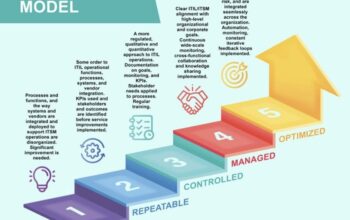IT leaders have a unique vantage point. They are the only business function that sees the entire organization at a process, data, and transaction level. This cross-functional and multi-dimensional view provides IT with the opportunity to identify cross-departmental process and technology synergies, use internal technologies designed for one part of the organization in other areas with similar operational needs, and assess newly released software and hardware products for applicability across the business.
Because of their cross-functional view, CIOs are well-positioned to be thought leaders in the organization, becoming leading internal voices for both discipline-based innovations (i.e., those impacting a single department or job type) and functional-based innovations (i.e., more general process and technology enhancements).
This puts CIOs at the intersection of business and technology—what I like to call the Golden Triangle:
- Understanding IT megatrends
- Understanding industry-specific business issues
- Understanding the intersection of the two
Understanding IT megatrends. It has been a fascinating time to watch the continued and accelerated movement in software and hardware technologies that can be employed by IT for business purposes. This includes advances in machine learning, blockchain, cyber security, cloud computing, virtual/augmented reality, edge computing, facial recognition, chatbot technology, the list goes on and on. You may look at this list and think these innovations are not new, and in truth, many of them have been around for years. But as time moves forward, they get more mature, function-rich, and capable of being incorporated into standard production IT systems.
As IT executives, it’s easy for us to only look inward into our company’s current technologies, identified business needs, and software applications tailored to our specific industries. This is not from a lack of interest but a lack of time. But to embrace the thought leadership role, you should widen your focus to include these five categories:
- Technologies traditionally used in other industries;
- Emerging technologies that could potentially give your company a competitive edge;
- Technologies you already have in house that you could use in different ways;
- Technologies used by your competition; and
- Technologies used by your most technically sophisticated customers/clients.
Understanding your industry. This leg of the triad is about understanding your business partners, your company’s role and effectiveness in the marketplace, the competitive landscape, and industry trends. You should also be watchful of the general economy, federal and state legislation related to your industry, customer demographics, and other external factors related to your industry.
The Golden Triangle aside, gaining this business knowledge has many other professional benefits. You’ll be better at anticipating your business partners’ and clients’ needs, which will enhance your current job performance. And you’ll be more likely to get a seat at the business strategy table because you can talk with your peers from a business as well as a technical perspective.
Understanding the intersection. This third point on the triangle is about transforming from being a “knowledge collector” to a “knowledge provider.”
While fluency in both technology trends and industry business issues is a strong basis for providing thought leadership to your IT team, business partners, and organizational leadership, you’ll also need to master the following traits that are the embodiment of IT thought leadership:
- Holistic perspective—Seeing the big picture.
- Innovative thinking—Identifying new business opportunities.
- Information sharing—Effectively communicating with your team, peers, and organizational leadership.
Taking these steps will go a long way toward enhancing both your professional reputation and IT’s overall value to the organization.



